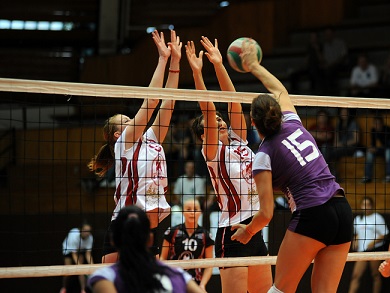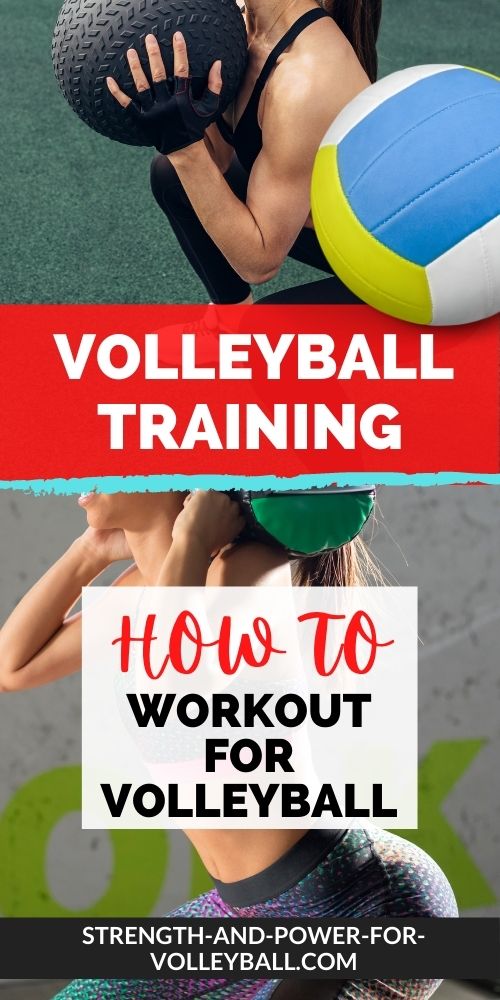- Home
- Conditioning
- Training Volleyball Systems
Training Volleyball
Systems for Explosive Volleyball
Training volleyball systems and what you need to know about the muscular and nervous system.
To capitalize on a muscle's utmost potential to gain strength and speed, an athlete must raise the level of excitement in the muscle fibers and challenge them when they reach their highest potential.
Wake up your body with a dynamic warm up
A dynamic warm up will improve speed and power output by nearly 20% compared to static stretching.
Warm up properly to prepare your body for explosive spiking
A dynamic warm up prepares your body to move.
It boosts heart rate, blood flow to the muscles, and raises core temperature.
A dynamic warm up is essential and nothing else provides so much value in so little time.
It also improves the function of the nervous system.
Improving speed and power output
Think of the dynamic warm up as taking a few minutes to warm up a car thats been sitting outside in cold temperatures all night.
The end result of the dynamic warm up is a significant improvement in mobility, flexibility, and stability.
How dynamic stretching is different than traditional static stretching...
During dynamic stretching, as you stretch the muscle to a new range of
motion, you also contract the muscle. You're actually using this muscle
in a
stretched position.
By stretching in this way, you are strengthening muscles in a new range of
motion and working all the tiny stabilizer muscles around your
joints that help hold the joints together. This will improve your
posture and performance and decrease the potential for injury.
So you can see why a dynamic warm up is so important for volleyball.
Maybe the most important effect of dynamic exercises is the fact that
they spark your nervous system by activating all these little muscles.
Warm up dynamically to improve your score on the vertical jump test...
If you want to perform well on a vertical jump test, a good dynamic warm up can make a big difference.
High knees, high heels, power skips, the inch worm, and inverted hamstring walks are great volleyball exercises that will wake up your nervous system
and prepare your body to move explosively. And of course
you should do jumping exercises during your warm up.
Once you're warmed up pretty good, perform explosive jumping exercises such as knee tucks
or power skips. The focus should be to jump high and have a short foot
"contact time" with the ground.
Note: There are some static stretches you can do to help improve your jump. For example,
stretching your hip flexors can help improve your jump because if these muscles are tight, they can actually prevent you from
the powerful hip extension you need to jump high.
This is one of the rare times static stretching
can help your performance on the vertical jump test.
Static stretching is basically the opposite of stretching dynamically. Static
stretches put your muscles to sleep whereas dynamic stretches wake up your
muscles.
You don't want to perform static stretches prior to testing because static stretches relax your muscles. You
want to activate your muscles by contracting them.
Static stretching basically "shuts off" your nervous system.
Basically, there is an optimal resting length for your muscles to work the most efficient.
If the muscles aren't at the optimal length, potential for force production isn't the greatest, and they won't contract as well and you won't be as explosive and powerful when you play volleyball.
If you enjoyed these tips and would like to keep it close to you at any time, just save this pin to your Pinterest Volleyball Training Board.
How the Nervous System and Muscular System Work Together
Having an overall perspective on how your muscular, nervous, and
cardiovascular systems work together will help you be more successful in
training for volleyball.
You can think of the muscular system as a computer system, and the nervous
system as the software.
The nervous system triggers a muscle's response to a stimulus, telling it what to do and when to do it.
The neurons also tell a muscle fiber whether it should behave like a fast-twitch muscle fiber or a slow-twitch muscle fiber.
A motor unit is a single motor neuron and all of the corresponding
muscle fibers it innervates. When a motor unit is activated, all of its
fibers contract.
Groups of motor units often work together to coordinate the contractions of a single muscle.
A motor unit consists of three components...a motoneuron, motor axon, and the muscle that's told to contract.
Larger motor units have stronger twitch tensions.
A motoneuron is a neuron conducting impulses outwards from the brain or
spinal cord. The motoneuron tells the muscles to contract.
The motor axon takes the information from the central nervous system and gives it to the muscle fiber.
The motoneuron tends to be attached to more than one muscle fiber.
When a single motoneuron is excited, all the muscle fibers attached to it are stimulated simultaneously.
It's like lighting a fuse on a firecracker...
This process is like lighting a fuse on a firecracker. The central
nervous system sparks the process, sending the signal down the axon
towards the muscle fibers.
Why is this important to know when training for volleyball?
Basically, the more efficient the process, the better trained the athlete.
The muscular system's interaction with the nervous system
Your body has skeletal muscle made up of different muscle fibers. The
gifted athlete whom everyone loves to hate has probably inherited
a predominance of fast-twitch muscle fibers. Many athletes have a
predominance of slow-twitch muscle fibers, which is why they don't
start,
accelerate, and change directions as quickly.
The muscular system needs to be trained in conjunction with the nervous
system in such a way that the slow-twitch fibers are taught to behave
like
fast-twitch fibers.
The Role of the Cardiovascular System
In the United States, too much emphasis has been placed on aerobic training.
Don't make the mistake of having aerobic training a dominant component of your
volleyball conditioning
program.
Aerobic training for strength and power athletes is out of the question.
Aerobic training may help an athlete recover from high-intensity exercise, but it does so
at the expense of speed and power and increases
the risk of overuse injuries and overtraining.
The Neuromuscular Connection
The number of muscle fibers an athlete has and the types of fiber in these muscles are both important factors.
As you continue to train for strength and power, the nervous system
learns the necessary skills and hypertrophy (muscle growth) takes over
the limelight.
Teaching the muscles...
The concept of "teaching the muscles" is known as motor learning.
Motor learning is a segment of the training process dominated by the nervous system.
A properly designed workout for volleyball will maximally excite the nervous system,
getting the best results from training.

